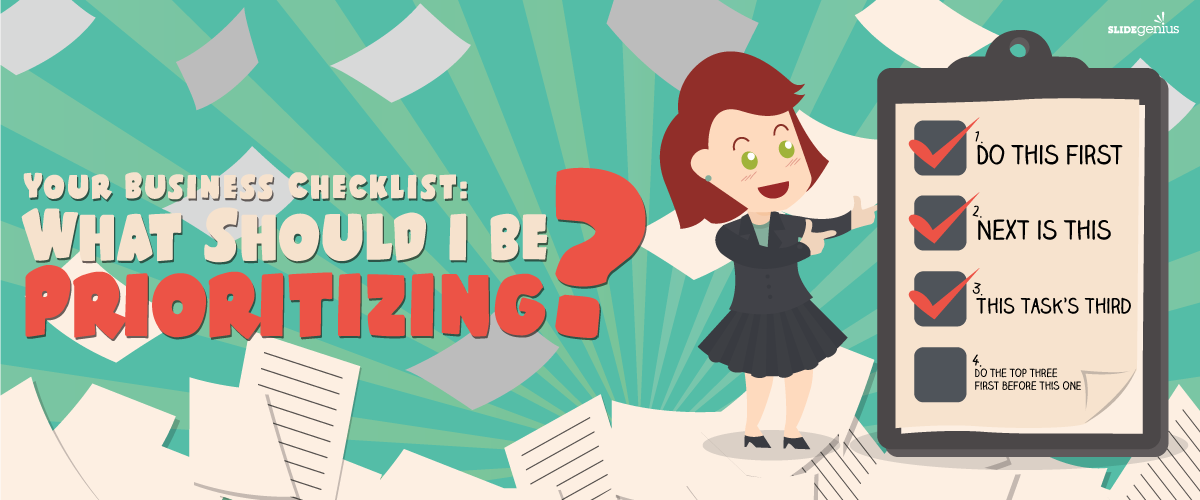How much time do you spend on presentation preparation? One week? Two days? A few hours? It’s not the length of time that actually matters, but how much preparation you do. The real secret to a great presentation is sufficient preparation. It’s the one thing all skilled presenters do. They don’t just take the podium thinking they can “wing it”.
If you feel like you’ve been giving presentations that are subpar, it’s probably because you don’t prepare enough. If you want to engage your audience and leave them with a memorable message, you need to some heavy lifting.
Here’s a list of things you need to cover in your presentation preparation:
1. Establish your goal
Before you even think of doing anything else, ask yourself what the end goal of your presentation is. What do you want to achieve through this presentation? What’s the one thing you want your audience to take from it?
Answering these questions will give you an idea which direction to take your presentation.
2. Know your audience
The members of your audience are key players in your presentation. They’re the ones you need to convince and impress. You need to be able to engage them to action. How are you going to do that if you’re totally clueless about who they are?
You need to know where your audience is coming from to know how to create a connection with them. To do that, learn as much information as you can about their backgrounds, and what that could possibly say about their knowledge on the topic you’re going to be speaking about.
Similarly, try to research as much information about the event or conference you’re participating in. Is it an industry event where you can speak in more technical terms? Or is it a seminar for aspiring leaders where you need to inspire and motivate?
3. Draft and outline your ideas
With an established goal and enough knowledge on the context of your presentation, you’ll find yourself forming more and more ideas. Draft all your ideas on a sheet of paper and start making a rough outline of your presentation. It’s best to keep this part analog, as explained by presentation expert Garr Reynolds.
It’s best to let your ideas flow on paper. Just keep on writing and stop only until you’ve ran out of things to write. Don’t edit out anything yet. When you’re done, review what you’ve written and figure out the key points you want to make. If you have to, re-arrange your points to create a clearer and more logical flow.
4. Work on your content
As we’ve pointed out time and again, strong content is crucial to your presentation. It’s not enough to present your ideas through a series of bullet points. You need to tell a story with a beginning, middle, and end.
As you work on writing your presentation content, keep in mind the core message you want your audience to take home. Go back to the goal you’ve established and make sure that it’s clear in everything point you make. Don’t make the mistake of overwhelming your audience with too much information. As the presenter, you have to be able to discern which of the data is the most important to your overall message.
5. Design an effective PowerPoint deck
According to Dr. John Medina, vision trumps all other senses. A majority of people will find it easier to retain information if it’s presented with images. If you want to engage your audience, give them a presentation that’s highly visual. Create a PowerPoint deck that will emphasize your key points by effective use of design principles.
The general rule for PowerPoint design is to keep things simple by using minimal text coupled with high-quality illustrations or images. Another thing to remember is that you have to keep your design cohesive with the story you’re presenting. If you’re representing a business, make sure your brand is evident in the slides.
If you want to make sure that your PowerPoint design reflects the best of your story, professional PowerPoint services could be a worthy investment.
6. Plan what you’re going to wear
It might not be the most comfortable fact, but looks really do matter. Especially if you’re the one expected to face a large group of people. As the presenter, you have to look polished and professional. The audience will need to see that you’re someone they can rely on for information. Dressing sloppily will make you lose the authority you want to achieve.
Specific dress codes will depend on the event you’re presenting at, so remember to take note of that information during the initial parts of presentation preparation. The best way to gauge what’s appropriate to wear is by considering your audience. For example, you have to dress slightly better than the audience to stand out, but don’t appear too flashy to avoid being criticized.
7. Practice your presentation
Last but not least, you have to rehearse your presentation. You might feel silly doing it, but practicing will help familiarize you with every aspect of your presentation. Review your speech as much as you can and think about how you’d like to move on the stage. You should also rehearse how you plan to incorporate your PowerPoint deck into the presentation. Unexpected interruptions and distractions will less likely phase you if you’re familiar with your materials.
Conclusion
Presentation preparation is crucial to building a message that will make an impact on your audience. There’s no other way to go about it. The main goal of any presentation is to share knowledge and information. In order to do that, you can’t skip any steps.
The main goal of any presentation is to share knowledge and information. In order to do that, you can’t skip any steps.
References
“Organization & Preparation Tips.” Garr Reynolds Official Site. Accessed July 25, 2014.
“Vision.” Brain Rules. Accessed July 25, 2014.
Featured Image: kkirugi via Flickr





